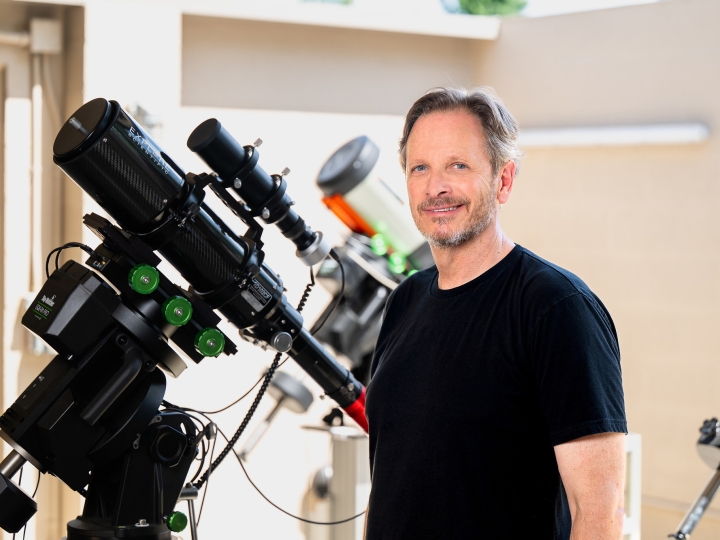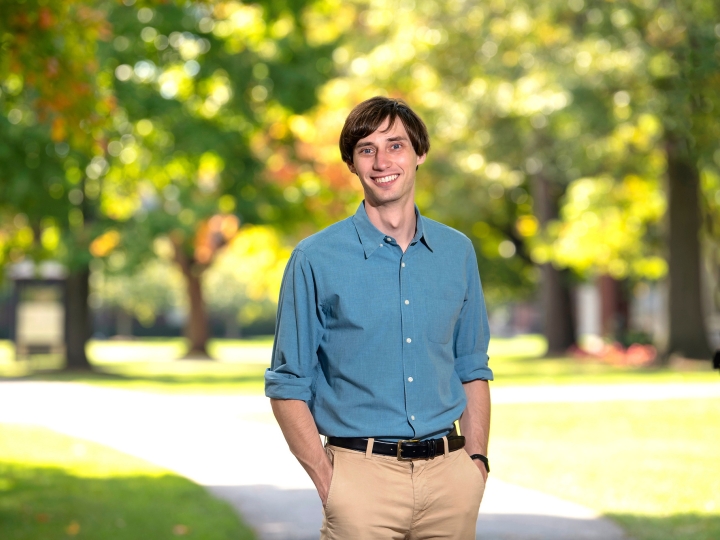
Douglas Collins, Chemistry
October 10, 2022
Professor Doug Collins, chemistry. Photo by Emily Paine, Communications
It’s an important time to help people learn about the indoor environment, as we’re trying to keep our homes, offices and schools as clean and healthy as possible.
There's much to be discovered about how the chemicals we introduce into our indoor spaces interact with the surfaces that surround us. Even less is known about the potentially harmful effects those products could produce in invisible reactions every day.
"We don't know enough about them, we don't know how to measure them, and we sometimes don't know that they're even there if we aren't looking for them," says Professor Douglas Collins, whose vast indoor air chemistry research seeks to isolate and analyze the abundant reactions between common household chemicals and home surfaces. "One of the things I aim to do, in collaboration with students, is produce standard techniques to evaluate these kinds of chemical systems."
In pursuit of that goal, Collins has teamed up with student researchers to design and conduct experiments on the reactivity of common chemicals like bleach, nitrous acid and third-hand cigarette smoke. Indoor surfaces, they've found, can act as reservoirs of these highly reactive compounds and often continue releasing them into the air over long periods, despite ventilation. Other oxidizers like ozone react easily with cleaning agents deposited on surfaces, resulting in chemical byproducts that may be unhealthy or even toxic for humans.
During the COVID-19 pandemic, Collins has leaned even further into studying the chemistry of indoor cleaners such as hypochlorous acid (HOCl), which has been increasingly used in schools, businesses and health clinics for its ability to kill virus particles on surfaces. While the compound is marketed as a safer alternative to bleach, the two may bear more similarities than differences.
"HOCl actually behaves very similarly to bleach when it evaporates. Because it evaporates very quickly, about a third of the amount you're using on surfaces is going to end up in the air," Collins explains. "Many indoor chemists try to dissuade air purification using highly reactive chemicals because, while they might get rid of the pollutant, they could make lots of byproducts as well. Those byproducts are often worse than the pollutant you started with."
To demystify these reactions, Collins and two members of his lab will introduce HOCl and other reactive gases to chemical material collected from surfaces in homes, offices and other common indoor spaces. Then, using a state-of-the-art mass spectrometer purchased through a 2020 National Science Foundation grant, they'll identify the type, concentration and formation rate of the products created. The study, funded by the Surface Consortium for the Chemistry of Indoor Environments, is especially significant given that "we spend 90% of our time indoors in the developed world, even more so during a pandemic."
It's also an exciting opportunity for Bucknell undergraduates to blaze a trail in an understudied but expanding area of chemistry. Watching students gain confidence in grappling with complex and sometimes muddy questions and solutions is consistently one of the most rewarding results for Collins.
"Research is all about trying to process a problem that doesn't necessarily have a clear answer, which I think can intimidate students at first. But soon, they're coming to me with ideas and new questions as they refine the way they think about science," he says. "That transformation from being nervous of the unknown to being an excited explorer is a key experience for the students who learn in our labs."

